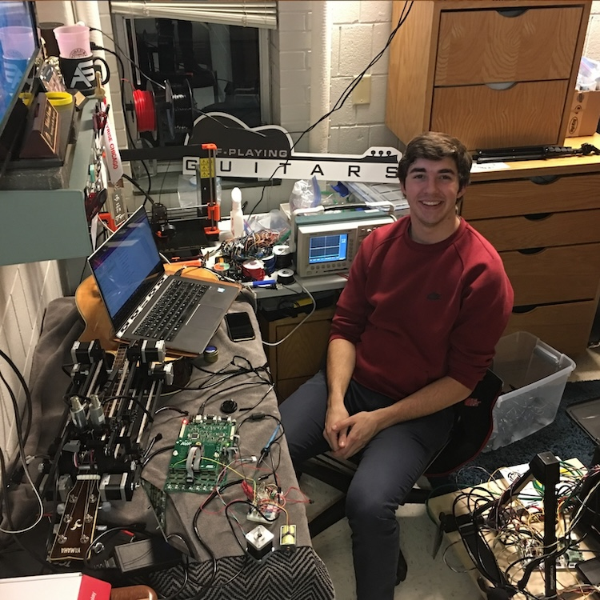Behind the scenes of a self-playing guitar
“It was 3:00 a.m. in my dorm room in Williams, and I couldn't sleep,” electrical engineering major Michael Kuzma ’20 said.
The nagging thought that kept him awake: “I wondered if a self-playing guitar exists.’”
After a quick Google search revealed little in the realm of robotic guitars, Kuzma wrote up two pages on how he would go about engineering one, then tucked in for the night.
A few days later, Kuzma cornered some Caterpillar engineers during a career visit day to pick their brains. Taking notes on Chick-fil-A napkins, they brainstormed ideas for how to bring his concept to fruition. The biggest takeaway from their conversation? If Kuzma could get just one string to play one note, the rest would soon follow.
At the same time, Kuzma was studying concepts that would become pivotal during the build. “My most influential class was Microcontroller Theory with Gary Dempsey,” Kuzma said. “I had my aha moment while taking that class and I thought, ‘Oh. That's how I'm going to do it – via a microcontroller.’ I didn't know what a microcontroller was until that class.”
One string at a time, the lifelong guitar player got to work figuring out all over again the nuances behind picking and fretting – this time using robotics.
“Much like a real musician, this has gone through the musician's journey of ramping up the first year, playing chords, then getting that nuance and perfection,” Kuzma said. “It takes hundreds of hours to get that little bit of improvement on the overall output.”
As the months of incremental improvements passed, he started looking for somewhere to hang his hat as he prepared to travel to Granada, Spain through Bradley’s study abroad program.
“I wanted to learn flamenco guitar where it originated,” he said.
It was time for a trial of his self-playing guitar to collect valuable feedback to ponder over while abroad. As such, Kuzma set up his self-playing guitar at a retirement home in Streator, Ill, so residents there could test it out for a week. Upon his return, they let him have it, telling him everything they didn’t like about his robotic guitar: “They said, ‘It smells like fire.’ ‘We don’t like parts falling off the machine as it’s playing.’ And, ‘We don’t recognize any of the music,’” he relayed.
He took their feedback to heart and worked on improving his invention over the next year. He redesigned the picking system such that the mechanics were silent enough to let the notes from the strings ring out and improved the construction to make it more sturdy.
The project would eventually become Kuzma’s senior project at Bradley, accompanying him through graduation and becoming his side project while working full-time making by-wire systems (technology similar to what’s driving his self-playing guitar) for AutonomouStuff in Australia.
Despite the opportunities for incremental improvements, Kuzma’s side business has begun slowly fulfilling orders, with the first shipment going out in early 2024. Much like any other musician, the device’s strengths and weaknesses differ from Kuzma as a player.
“I think my strengths as a guitar player are the technical aspects, like playing percussion while finger-style picking. Can my robot do that? Not at all,” he said. “Can my robot play hundreds of more songs than me? Yes, and it can pick faster than any human on the planet.”
When asked if he’s proud of his invention, he has a surprising response: “Personally, I'm its biggest critic, because I'm just envisioning that next one. I've made much progress, but there's a long way to go.”
For Bradley students looking to follow in Kuzma’s footsteps and turn their passion into a viable product, he has some advice:
“Tell people what you want. No one knows how they can help you unless you tell them. If you project what you want and what you're thinking, they will do anything in their power to help you. Especially in a community like Bradley.”
– Jenevieve Rowley-Davis






